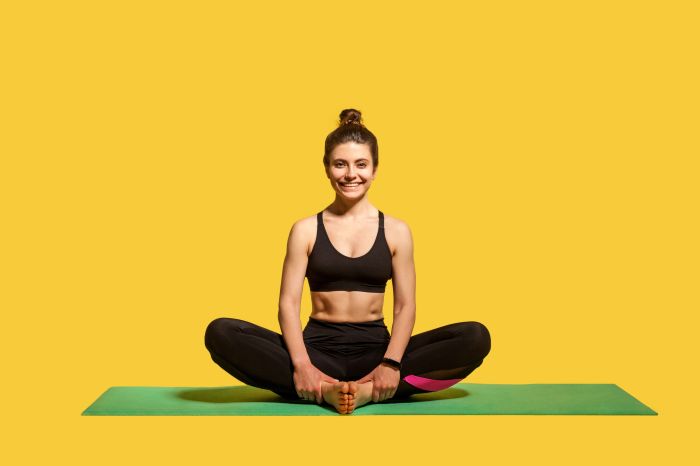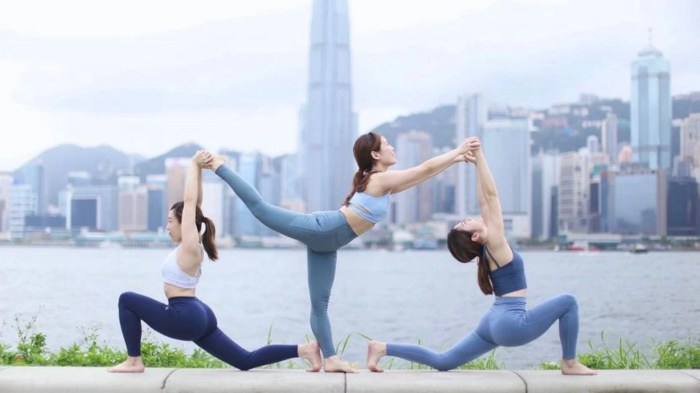Yoga for Beginners introduces you to the world of yoga with a focus on essential tips, poses, and benefits tailored for those just starting their practice. Dive in and discover the path to a healthier and more balanced lifestyle.
Benefits of Yoga for Beginners
Practicing yoga as a beginner can bring a wide range of benefits, both physically and mentally. Let’s explore how starting a yoga practice can positively impact your overall well-being.
Physical Benefits
- Improves flexibility: Yoga poses help stretch and lengthen muscles, improving overall flexibility and range of motion.
- Builds strength: Holding yoga poses requires muscle engagement, helping to strengthen various muscle groups throughout the body.
- Enhances balance: Yoga poses focus on stability and alignment, which can improve balance and coordination over time.
- Aids in weight management: Regular yoga practice can help maintain a healthy weight by promoting physical activity and mindfulness in eating habits.
Mental Health Benefits
- Reduces stress: The emphasis on deep breathing and mindfulness in yoga can help lower stress levels and promote relaxation.
- Boosts mood: Yoga releases endorphins, the feel-good hormones, which can elevate mood and reduce symptoms of anxiety and depression.
- Improves focus: The practice of yoga encourages present moment awareness, enhancing concentration and mental clarity.
- Promotes better sleep: Relaxing yoga poses and breathing exercises can help calm the mind and prepare the body for restful sleep.
Essential Yoga Poses for Beginners
Yoga poses are an essential part of any yoga practice, especially for beginners. Mastering basic poses is crucial before moving on to more advanced ones as it helps build a strong foundation and prevents injuries. Here are some fundamental yoga poses suitable for beginners along with tips on how to perform them safely and effectively.
Mountain Pose (Tadasana)
Mountain Pose is a standing pose that focuses on alignment and grounding. To perform this pose:
- Stand tall with your feet hip-width apart and distribute your weight evenly.
- Engage your thigh muscles, lengthen your tailbone, and lift your chest.
- Relax your shoulders down and back, with your palms facing forward.
- Breathe deeply and hold the pose for a few breaths.
Downward Dog (Adho Mukha Svanasana)
Downward Dog is a foundational pose that stretches the entire body and builds strength. Follow these steps to practice this pose:
- Start on your hands and knees, then lift your hips up and back, forming an inverted V shape.
- Press firmly into your hands and feet, keeping your back straight and your head between your arms.
- Engage your core muscles and breathe deeply as you hold the pose.
- Modify by bending your knees if needed to maintain proper alignment.
Child’s Pose (Balasana)
Child’s Pose is a resting pose that helps to release tension and calm the mind. Here’s how you can practice this pose:
- Kneel on the floor with your big toes touching and knees apart, then sit back on your heels.
- Extend your arms in front of you and lower your chest towards the mat, resting your forehead on the floor.
- Breathe deeply into your back and relax your entire body in this gentle stretch.
- Stay in the pose for a few breaths or longer if needed to rest and recharge.
Tips for Starting a Yoga Practice

Starting a yoga practice can be both exciting and challenging for beginners. Here are some tips to help you establish a consistent routine, find the right resources, and set realistic goals:
Establishing a Consistent Routine
- Choose a specific time of day that works best for you, whether it’s in the morning to energize your day or in the evening to unwind.
- Start with shorter sessions and gradually increase the duration as you build strength and flexibility.
- Create a dedicated space in your home for yoga practice to minimize distractions and make it easier to commit.
Finding the Right Resources
- Consider taking a beginner’s yoga class either in person or online to learn the basics from a qualified instructor.
- Explore reputable websites, apps, or YouTube channels that offer guided yoga sessions for beginners.
- Invest in a good quality yoga mat and props to enhance your practice and prevent injuries.
Setting Realistic Goals and Expectations
- Avoid comparing yourself to others and focus on your own progress and growth on the mat.
- Be patient with yourself and understand that progress in yoga takes time and consistent practice.
- Listen to your body and modify poses as needed to prevent strain or discomfort.
Common Mistakes to Avoid in Yoga Practice: Yoga For Beginners

When starting your yoga journey, it is important to be aware of common mistakes that beginners often make. By understanding these pitfalls, you can prevent injuries and develop a safe and sustainable yoga practice.
Improper Breathing Techniques, Yoga for Beginners
- Avoid holding your breath while in yoga poses, as this can lead to increased tension and limit the benefits of the practice.
- Focus on deep, mindful breathing throughout your practice to help relax the body and mind.
- Remember to coordinate your breath with movement to enhance the flow of energy in your body.
Incorrect Alignment in Yoga Poses
- Ensure proper alignment in each pose to prevent strain on your muscles and joints.
- Listen to your body and make adjustments as needed to maintain alignment and avoid discomfort.
- Seek guidance from a qualified yoga instructor to learn the correct alignment for each pose.
Pushing Yourself Too Hard
- Avoid forcing yourself into advanced poses before mastering the basics, as this can increase the risk of injury.
- Respect your body’s limits and progress at your own pace to build strength and flexibility gradually.
- Remember that yoga is a personal practice, and it is important to focus on your own journey rather than comparing yourself to others.





